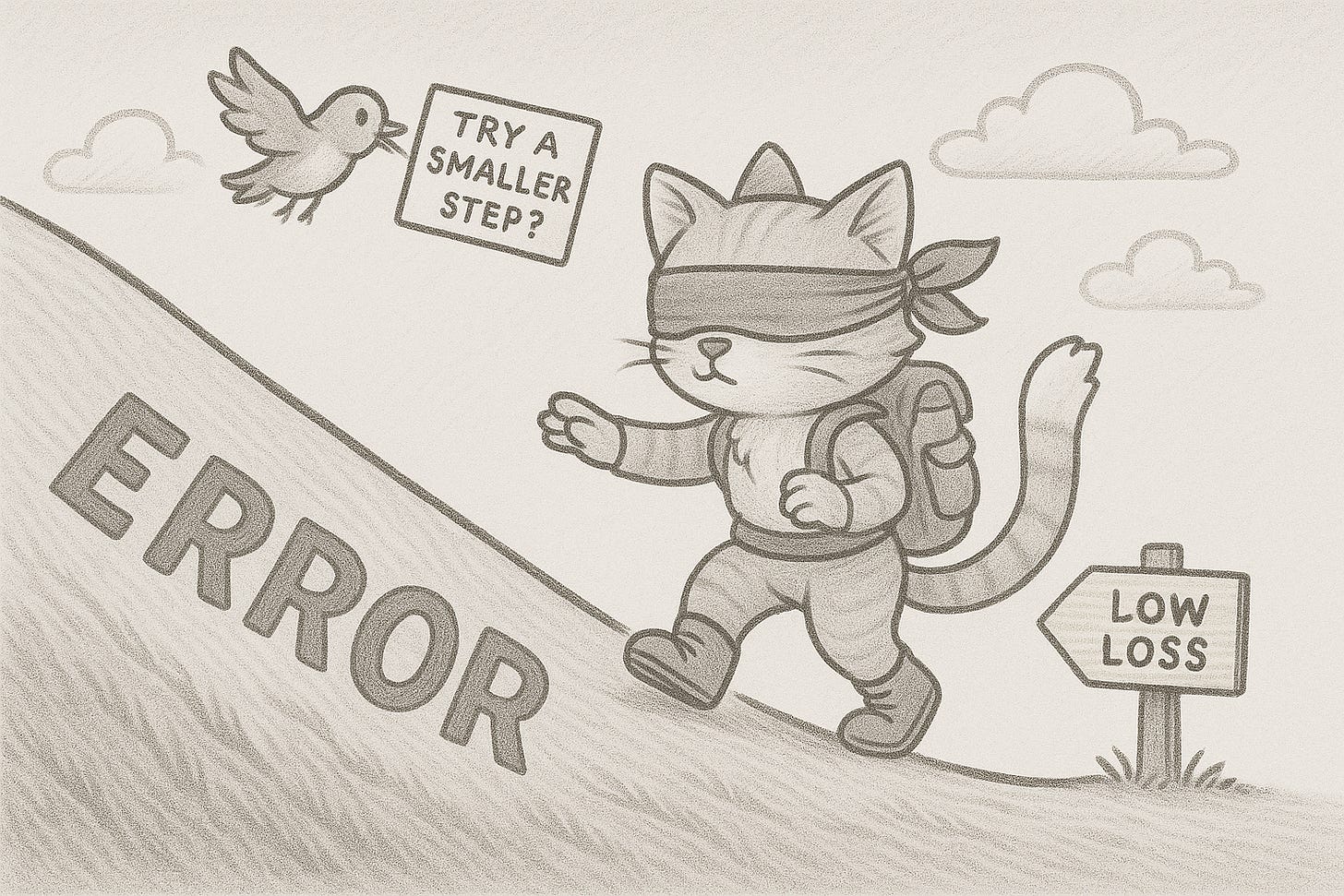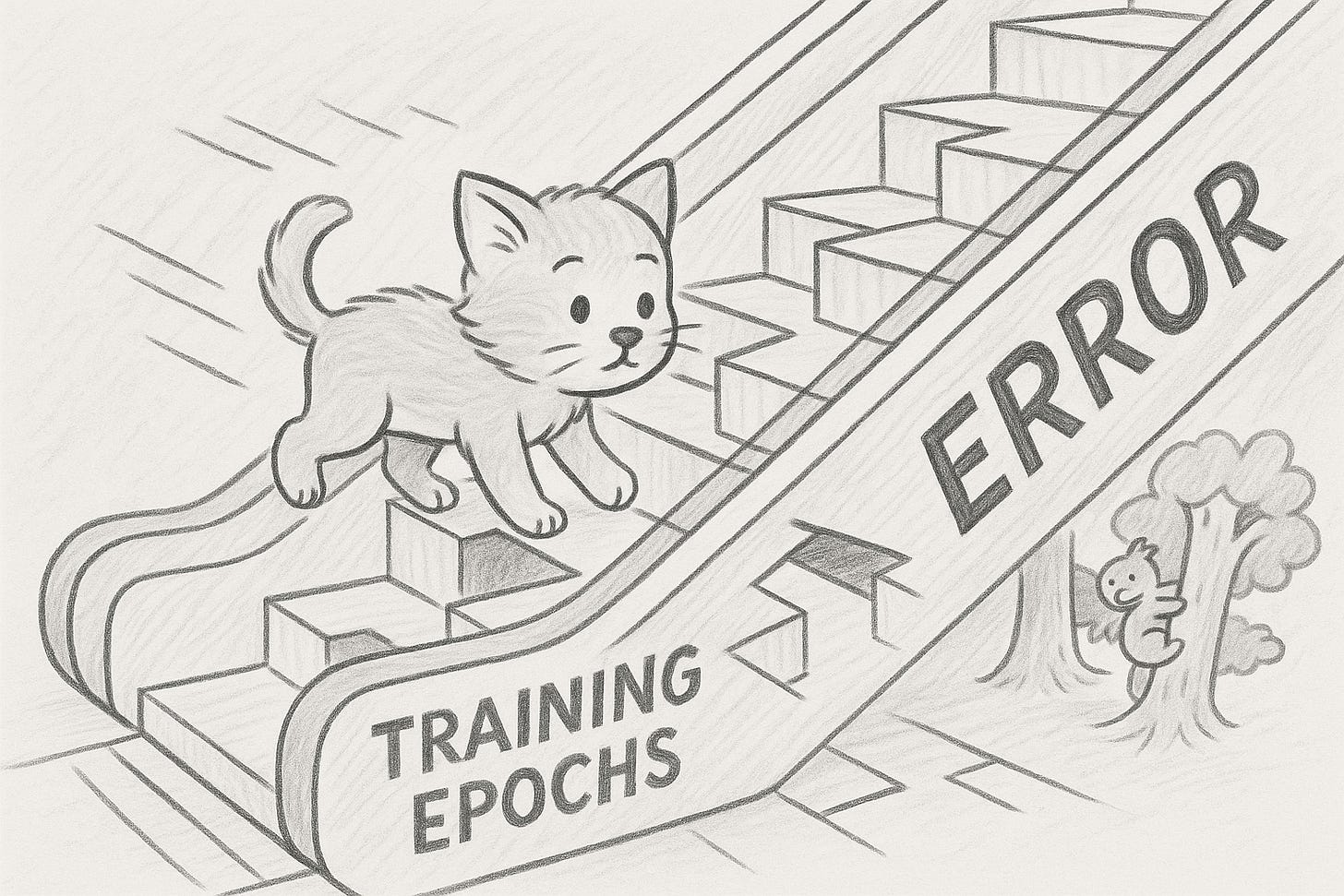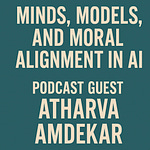A friend said to me recently:
“You don’t realize how much you know about this AI stuff. You should start breaking it down for people.”
Fair point. Yesterday, I began by defining the term "deep learning."
Put simply, we said: it’s how machines learn from data, layer by layer—like a brain made of math.
But today? I’m going with a much less obvious choice.
Why?
Because I want to make a point:
Even the most intimidating terms in AI can be made understandable—if you slow down, break them apart, and explain them like you would to your favorite aunt.
Today’s term?
Stochastic. Gradient. Descent.
It sounds like a lion. But we’re going to break it down into kitten-sized steps. (I blame the cat metaphors on all the Sora2 cat-playing-fiddle videos flooding my feed.)
But no more catting around.
Let’s get into it.
🐾 The Hiker Kitten on the Hill
Imagine a blindfolded kitten trying to tiptoe down a hill labeled “Error.” At the bottom? A little wooden sign that reads Low Loss.
The kitten doesn’t have a map. It doesn’t see the full terrain. But it takes small steps, feels which way the ground is sloping, and tries to move downward.
That’s gradient descent—the heart of how AI models learn. Step by step, they adjust in the direction that reduces error.
It’s how I walk down a hill, too. Don’t judge.
🎴 The Flashcard Learner
Now let’s add the “stochastic” part.
“Stochastic” just means random.
Instead of studying every flashcard in the deck before making a move, the kitten picks a few at random. It learns from small samples—just a mini-batch—not the entire dataset.
Wrong answers get tossed in the bin marked Loss Function.
Right ones? Reinforced.
That’s how the model learns. Not by memorizing everything, but by trying, adjusting, and trying again.
That coffee cup way too close to the edge? Totally bothering my OCD.
🪜 The Escalator of Errors
Now picture our kitten on an escalator made of training epochs—steps that represent each pass through the data.
But here’s the twist: some steps are missing. Some are uneven. The kitten has to guess where to land next.
That randomness doesn’t confuse the model. It helps.
It prevents the model from getting stuck in local patterns and nudges it toward broader understanding.
I felt this once on the Great Wall of China.
The steps were wildly inconsistent—a deliberate defensive design to slow down invaders. Varying heights and unexpected changes forced enemies to look down, making them off-balance and vulnerable.
And that’s exactly what happened to me.
Except I had more time than someone expecting an ambush. After navigating these steps for a while, something shifted. The irregularity forced me to stay alert, to feel each step instead of zoning out. I couldn’t fall into autopilot.
That’s exactly what randomness does for SGD.
It prevents the model from getting stuck in comfortable patterns. The unevenness—the stochasticity—nudges it toward broader understanding instead of memorizing one predictable path.
The randomness doesn’t confuse the model.
It sharpens it.
🧁 The Mini-Batch Diner
And finally—let’s eat.
The kitten now works at a 1950s-style diner, serving bite-sized data meals to a neural net robot. Each plate is a mini-batch: a little bit of input, a little bit of feedback.
With each bite, the robot learns something new. And slowly—predictably—it gets better at recognizing patterns.
No all-you-can-eat buffet here. Just small plates, served with precision. And eventually? The robot is trained.
It also appears the robot has mastered the Force and can levitate plates of peas.
Cool. A whole different kind of training, but cool.
If stochastic gradient descent feels familiar, that’s because it is.
It learns the way a kitten learns to hunt.
Not by understanding prey behavior or studying trajectories, but through pounce and miss.
The kitten crouches. It leaps. It misses.
Each attempt sharpens its timing—not by grasping the full picture, but by feeling what almost worked.
We learn the same way.
Structure. Feedback. Repeat.
A small guess. A course correction. Then another.
It’s the process of trying, failing, and adjusting. It’s how we learn anything that matters.
SGD follows this same pattern. It makes a move. The loss responds. It adjusts.
It doesn’t need to see the entire landscape to know which direction improves things.
It just needs direction—and the patience to take the next step based on what it just learned.
Neural networks aren’t human. They don’t think or feel.
But the process of training them—of slowly shaping better performance through repeated feedback—echoes something deeply human.
And that makes them much easier to understand.
Key Terms
Gradient: The direction that reduces error the fastest.
Descent: Moving in that direction, step by step.
Stochastic: Involving randomness or partial samples.
Mini-batch: A small slice of data used for one learning update.
Epoch: One full pass through the training data.
🐾 FAQs
What is stochastic gradient descent, really?
It’s how AI learns—by guessing, checking, and adjusting. Over and over. The “stochastic” part means it learns from small samples at a time, not everything at once. Like a kitten learning with flashcards instead of a textbook.
Why does it use randomness?
Speed. If the kitten had to review everything before each decision, it’d never get anywhere. Small, random samples help it learn faster and avoid getting stuck.
Why is it called “descent”?
Because it’s trying to go downhill—toward fewer mistakes. Like a kitten walking down to a bowl of food, it’s heading to the bottom where errors are lowest.
Do I need to know the math?
Nope. You don’t need calculus to understand a kitten learning to walk. This is about steady improvement through small steps—not formulas.
Is this how all AI models learn?
Most do! There are variations, but this process powers most modern systems—language models, image recognition, you name it.
Why choose stochastic gradient descent on day two? Because it sounds like one of the most intimidating terms in deep learning—and I wanted to prove something early: Even the scariest-sounding concepts are surprisingly simple once you break them down.
#deeplearning #stochasticgradientdescent #machinelearning #neuralnetworks #aiexplained #writingaboutai #kittenlevelai #curiousmind #funwithai #deeplearningwiththewolf
About the Video
The video was generated using Google’s NotebookLM. In place of a prompt, I wrote a
script so that the video aligns with the article. Send me a PM if you’re interested in learning more about the process. I’m happy to share.












